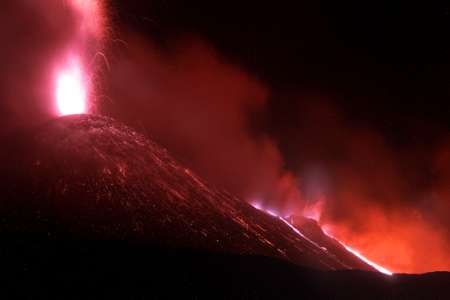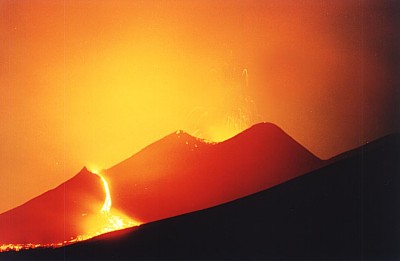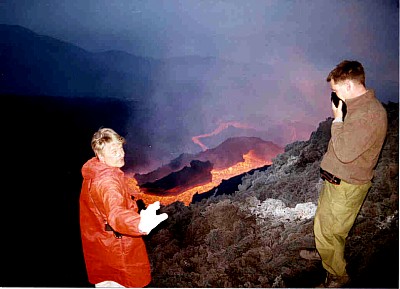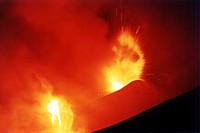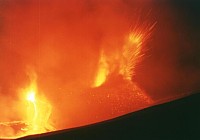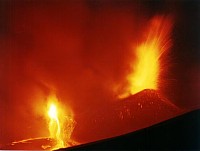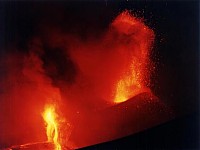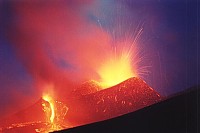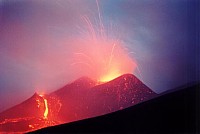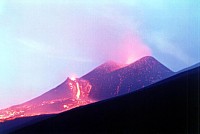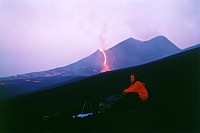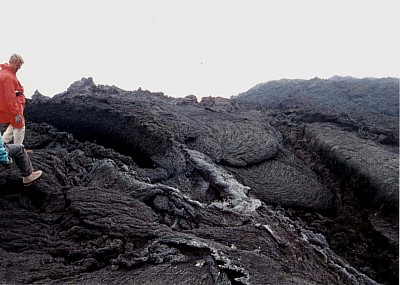|
WARNING:
Access to the summit area is VERY
DANGEROUS and ACCESS TO THE SUMMIT CRATERS IS FORBIDDEN.
The regime of eruptive activity at the Southeast Crater has
changed once more, and episodes of vigorous explosive and effusive
activity might occur with relatively little warning. Guided
excursions on the south flank that end at the Torre del Filosofo,
at about 2900 m elevation, have resumed in mid-March, and on
the north flank excursions arrive at 3100 m elevation, on the
E side of the main summit cone. Tourists
should make excursions only with the mountain guides and NEVER
GO ALONE, even though this will not satisfy the wish
to see what's going on at close range. Besides this, weather
conditions are often unstable: strong wind, snow or rain and
clouds are occuring frequently in the summit area, even during
the summer, and one can get easily lost. The mountain guides
can be contacted at the cable car (near the Rifugio Sapienza)
on the southern side of Etna (phone: 095-914141), or (during
the summer) at the hotel "Le Betulle" at Piano Provenzana,
on the northern side (phone: 095-643430). There
is now a new web site giving more information about guided excursions
on Etna.
|
Do you look for books or videos about
volcanoes, volcanology, or in particular Mount Etna? Find and buy
them at Amazon.com!
This
ad helps to keep this site alive
|
|
|
PAROXYSM AT THE SE CRATER ON 12-13 JUNE
2001: Time exposure of the erupting Southeast Crater (the
twin-peaked cone in the right center) and its satellite vent
"Levantino" (at lower left) as seen from north during
the early morning of 13 June. A river of fluid lava is extending
northward from the "Levantino", while Strombolian
explosions eject glowing bombs at the summit vent of the SE
Crater. Photo courtesy of Thorsten Boeckel. More photos of this
event can be seen at the bottom of this page
|
|
|
|
ON THE "LEVANTINO", 23 MAY 2001:
Access to this vent was less dangerous when the activity was
still continuous (with lava effusion from the "Levantino"
and mild Strombolian activity from the summit vent of the SE
Crater), although Boris Behncke's (left) gesture indicates that
proceeding further might be unwise. Person at right is a member
of the Open University Geological Society excursion group that
visited Etna with Behncke in late-May. Lava spilling down the
eastern flank of the "Levantino" is visible in the
background. Photo by Chris Crivelli (OUGS)
|
The
latest update is near the bottom of this page
30 June 2001 update.
As expected,
the Southeast Crater and its NNE vent, now unofficially named "Levantino",
continued to produce eruptive episodes at intervals of 2-3 days, but
it seems that these events have become progressively weaker in terms
of explosivity. The following is a summary of eruptive activity at
Etna's summit craters during the period 15-30 June, based on numerous
sources of information. Giuseppe Scarpinati (Italian delegate of the
Paris-based Association
Volcanologique Européenne, or "L.A.V.E.") and
Marco Neri (Istituto Nazionale
di Geofisica e Vulcanologia, Sezione di Catania) are thanked for
providing near real-time oral and written information, and the Stromboli
On-line team, Charles
Rivière and Thorsten
Boeckel for posting information on their web sites. All times
are local (GMT+2 h).
15 June eruptive episode. Weak Strombolian activity
at the summit vent of the SE Crater was observed during the early
morning, and lava began to issue from the "Levantino" later
that morning. At about 1130 h, explosions at the summit vent increased
in intensity, including minor sustained lava fountains between 1150
and 1230 h. Strong fountaining occurred at the same time at the "Levantino"
which also emitted voluminous lava flows, and from other vents along
the fissure which connects that vent with the summit vent. This fissure
had not been active during previous eruptive episodes in June 2001.
A tephra column rose from the SE Crater; ash fell on the SE flank
of Etna. Toward the end of the paroxysmal phase, the summit vent produced
very powerful and loud explosions, ejecting huge bombs; the booming
sounds could be heard as far as Catania. During the late afternoon
of the same day, vigorous ash emissions began at the NE Crater, producing
a dense plume that was driven SSE by a strong wind. These emissions
ceased after a few hours.
17 June eruptive episode. Effusive activity at the "Levantino"
resumed during the morning and was soon accompanied by Strombolian
bursts from the summit vent of the SE Crater. At about 1250 h the
explosive activity increased, and the fissure between the summit vent
and the "Levantino" reopened, producing explosions and lava
flows. Lava fountains rose from the "Levantino" and in the
uppermost portion of the eruptive fracture, immediately below the
N lip of the summit vent, while the summit vent itself continued to
produce violent, but discrete Strombolian explosions. A tall eruption
plume formed above the summit vent, causing ash falls on the E side
of Etna. Then, as explosive activity at the summit vent waned, the
vents along the NNE fissure became more vigorous, until all activity
ceased at about 1630 h. Two (or three) lava flows were emitted from
the uppermost and lowermost vents of the eruptive fissure. This paroxysm
was accompanied by vigorous ash emissions from the Bocca Nuova.
19 June eruptive episode. After two days and six hours
of relative quiet, the "Levantino" and the summit vent of
the SE Crater reactivated to give lava flows and Strombolian explosions,
respectively, in the late afternoon of 19 June. By 2120 h, vigorous
explosive activity occurred at the "Levantino", and sometime
after 2200 h, lava began to issue from the uppermost vent on the eruptive
fracture between the "Levantino" and the summit vent. By
this time, continuous fountaining occurred at the earlier, while powerful
Strombolian bursts occurred in rapid succession at the latter, grading
into fountains 700-900 m high at about 2240 h. A heavy rain of scoriae
and bombs fell in a wide radius around the SE Crater, extending as
far as the Torre del Filosofo mountain hut to the S, and scoriae fell
even at Pizzi Deneri, about 3 km to the NNE. Observation from the
S revealed the formation of a small lava flow on the upper S flank
of the SE Crater cone, possibly produced by the copious fallout from
the lava fountain rather than by a true overflow or the opening of
new vents (during the numerous paroxysms of the year 2000, eruptive
activity had frequently occurred along a fissure on the S flank of
the cone, but the notch in the S rim of the summit vent has progressively
healed during the parxysms of June 2001). From 2330 h onward explosions
at the summit vent became more and more infrequent but at the same
time attained tremendous dimensions as huge bubbles of magma exploded,
showering the entire cone of the crater with huge incandescent blobs.
Explosions at the summit vent eventually ceased before midnight, and
lava effusion ended shortly thereafter.
This eruptive episode had been preceded by ash emissions from the
NE Crater on the previous day.
22 June eruptive episode. Lava extrusion from the "Levantino"
was first observed on the late evening of 20 June, less than 24 hours
after the previous paroxysm. However, the expected next paroxysm did
not occur until two days after, and lava emission even ceased during
the night of 21-22 June before resuming, more vigorously, during the
morning of the 22th. The first clear signs of the impending paroxysm
came at around 1430 h on that day when ash emissions began at the
summit vent of the SE Crater. Strombolian bursts became visible at
that vent at about 1730 h, and effusive activity at the "Levantino"
increased, followed by the onset of explosions at the "Levantino"
at 1820 h. At 1920 h, the "Levantino" became inactive, but
activity at the summit vent increased notably, and at about 1945 h,
the "Levantino" re-joined the party in a much more vigorous
manner than before. The activity was vigorous at 2000 h, producing
a tephra column 1-2 km high, and fountains from the summit vent rose
300-400 m high. Voluminous lava flows were emitted from the "Levantino"
and from the uppermost vent of the eruptive fissure below the NNE
rim of the SE Crater summit vent. Huge lava bombs were ejected from
the summit vent and fell onto the slopes of the SE Crater cone; more
intense tephra emission began at 2010 h, generating an eruption column
3 km high. At the same time activity at the "Levantino"
climaxed with fountains and high lava effusion rates. Then, at around
2030 h, the activity rapidly diminished, and by 2140 h, all explosive
activity was over.
24 June eruptive episode. On the early morning, lava
began once more to issue from the "Levantino", signalling
the beginning of the buildup for the 10th eruptive episode in this
month. Lava effusion continued throughout the day; shortly before
1900 h vigorous (lithic) ash emissions began at the Northeast Crater,
and at 2015 h the first Strombolian bursts were seen at the summit
vent of the SE Crater. The effusion rate progressively increased at
the "Levantino", which entered into explosive activity at
about 2130 h; 30 minutes later the eruptive fissure between this vent
and the summit vent opened along its full length. The summit vent
produced the strongest activity at about 2230 h, but it seems that
all of this consisted of closely-spaced Strombolian bursts rather
than continuous, sustained lava fountaining. The volume of lava emitted
from the "Levantino" was notable; the longest flows extended
up to 3 km from the source. At 2315 h, the activity began to diminish
visibly and ended at about 0050 h on 25 June.
This paroxysm occurred exactly one year after one of the most violent
paroxysms at the SE Crater, which was the 64th in a series of 66 paroxysms
during the year 2000.
27-28 June eruptive episode. Information for this paroxysm
is less complete than for the previous ones, but it appears that this
event was less powerful than its predecessors in terms of explosivity,
and the volume of lava erupted from the "Levantino" and
from at least one vent along the NNE fissure appeared smaller. Lava
emission began sometime during the evening of 27 June at the "Levantino"
and was followed by Strombolian activity at this vent and at the summit
vent, with ejections up to 400 m high. No sustained lava fountains
developed at any time during this paroxysm, which continued through
the early morning of 28 June (see photo at top of this page). However,
even after the end of explosive activity, lava continued to issue
from the "Levantino"; this activity continued at least through
the forenoon of 28 June. Since then, visual observations have been
frequently hampered by bad weather.
Since the onset of episodic eruptive activity at the SE Crater in
early June, repose intervals between eruptive episodes have been surprisingly
regular (2-3 days). Based on this regularity, a new (the 11th) eruptive
episode could be expected for today (30 June) or may have already
occurred without being visible due to heavy cloud cover.
1 July 2001 update.
The 11th
paroxysmal eruptive episode in less than one month at the SE Crater
has apparently occurred on the morning of 30 June, but a dense veil
of cloud has prevented visual observations of this event. It is thus
not known whether this latest paroxysm was stronger or weaker than
its predecessor, during the night of 27-28 June. The repose interval
between these latest two eruptive episodes was about 30-36 hours and
thus in the range of repose intervals typical of the current cycle
of episodic activity at the SE Crater. Based on the striking regularity
in the eruptive pattern seen in the past four weeks, another eruptive
episode might be expected within the next 24-48 hours (that is, before
noon on 3 July), and it is hoped that weather conditions will then
be more favorable.
|
Photos
of 23 May 2001, when the activity
at the Southeast Crater was still continuous
These
photos were taken by Chris Crivelli
(Open University Geological Society, Mainland Europe)
|
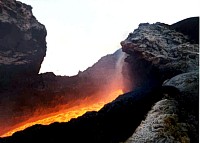 1
1 |
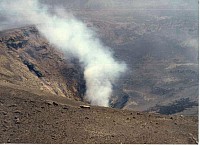 2
2 |
|
1.
This is how the active vent of the "Levantino" looked
like back on 23 May when there was constant, high-rate but non-explosive
lava emission at that vent. Approach to the vent was difficult
but not too dangerous, and the view of the flowing lava was
awesome
2. View
into the steaming central pit of the Voragine on 23 May from
the NW rim. This pit, formed during the violently explosive
eruptive episode on 4 September 1999 has not changed significantly
over the past year
|
|
|
|
PAHOEHOE LAVA NEAR THE "LEVANTINO",
23 MAY 2001: Drained ephemeral vent and associated flow
channel in the upper part of the lava field formed in the spring
of 2001 near the "Levantino", surrounded by unusually
smooth-surfaced pahoehoe lava (aa lavas are more typical of
Etna). Person standing at left is Boris Behncke. Photo by Chris
Crivelli (OUGS)
|
The
recent eruptive activity at Etna's summit craters is featured on several
web pages that contain additional information and highly spectacular
images. Some of them (Poseidon/INGV, Charles Rivière and Stromboli
On-line) have regular updates.
Etna
in 2000 - a list of all paroxysms at the SE Crater since 26 January
and photos (this site)
Etna
in 2000 - various pages at Stromboli On-line with photos and movie
clips of SE Crater paroxysms and Bocca Nuova gas rings: most photos
are of Marco Fulle, the artist photographer among us
Extremely
spectacular video clips, taken by British cameraman and film maker
David Bryant on 15 February 2000
At
"Italy's Volcanoes" -
At Stromboli On-line
An
interview with Boris Behncke, made in late February 2000 by a BBC
team
and a video
clip (RealPlayer)
Photos
of the eruptive activity, 15-23 February 2000, by Tom Pfeiffer (University
of Arhus, Denmark) - scroll to bottom of page
Alain
Catté (Association Volcanologique Européenne) has photos
of Etna
from many years
Photos
of an eruptive episode on 13 February 2000, posted on the web site
of the Association Volcanologique Européenne, Paris, France
Thorsten
Boeckel's web site (Germany) with photos and movie clips of several
paroxysm of the SE Crater in February, April and June 2000
A
small web page reporting on Etna's current activity - and check what
happens to your cursor on that page...
Charles
Rivière's Etna home page, with many photos and video clips
(the most recent of the paroxysm of 5 May 2000), frequent updates,
and other, highly interesting items (in French and English)

